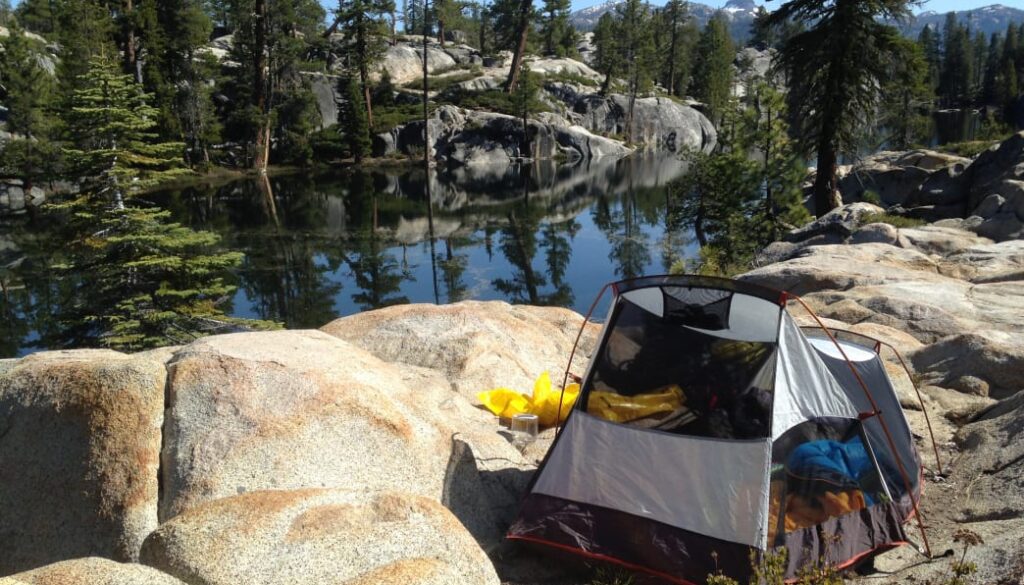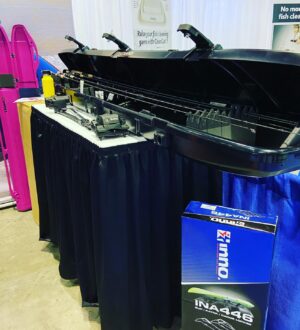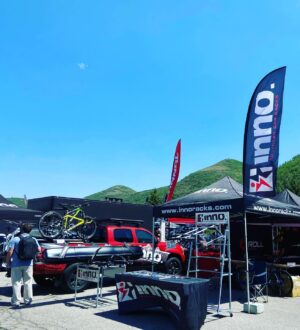Where to Go for Last-Minute Backpacking Trips in NorCal
With the summer solstice behind us, it’s now officially camping and backpacking season. In the Bay Area, this means that it’s officially time of year to escape the thick fog often blanketing the city.
The only problem? Popular campgrounds in the area have long since been booked for every weekend in the summer. But fear not: With a little savvy planning, you can still snag a spot—and ditch the crowds—by hitting the trail. While weekend campsites at state and national parks fill the minute the reservation system goes live, many world-class wilderness areas within reasonable driving distance of the Bay Area offer first-come, first-served backcountry permits. Better still, some wilderness areas have no trail quotas, which means you virtually guaranteed a spot under the stars no matter when you arrive to retrieve your permit. Here, details on seven nearby backpacking destinations for excellent last-minute backpacking trips in NorCal.
1. Yosemite National Park

Charlotte Dohrn
With soaring granite domes, gushing waterfalls, and notorious crowds, you might think of Yosemite NP as the perfect example of a place that’s next to impossible to get a reservation for the front country—or backcountry. But packed campgrounds and traffic jams are only the reality for Yosemite Valley and other main campgrounds. About 95 percent of Yosemite is a designated wilderness area, crisscrossed by 750 miles of trails. Backcountry camping permitted almost anywhere in the wilderness, as long as you follow the rules .
When planning your trip, the first thing to consider is that you must be at least four trail miles beyond Yosemite Valley, Tuolumne Meadows, and other heavily visited areas. Beyond that, the Yosemite Wilderness is yours to explore—as long as you have a valid backcountry permit. In the summer, 60 percent of the quota for each trailhead is reservable in advance, and reservations at popular trailheads fill up early. The remaining 40 percent of the quota is available first-come, first-served at ranger stations, beginning at 11 am the day before you start hiking. With minimal advance planning, a four-hour drive from San Francisco, and a few miles of hiking, you can fall asleep in some of the Sierra’s most striking landscapes.
2. Desolation Wilderness

Jonathan Fox
Desolation Wilderness, located in the Eldorado National Forest, beckons hikers with the promise of rugged peaks and sweeping views over the crystalline waters of Lake Tahoe. The wilderness area’s 15 trailheads allow access to more backcountry lakes than any other area around Lake Tahoe. Though it’s one of the state’s most popular wilderness areas, the forest service reserves at least 30 percent of the quota for first-come, first-served backpackers. Permits are available for pick up from a ranger station on the day you start your trip . Don’t want to take your chances on snagging a walk-up permit? There’s no quota system in place before the Friday of Memorial Day weekend or after September 30 ( though keep in mind that the weather turns stormy in fall, and much of the area is under snow in the winter). Consider hiking into the glacier-carved basin of Aloha Lake, dotted with granite islands, or planning a loop around the Velma Lakes. Peak baggers can summit Dick’s or Pyramid Peak, the tallest in the area.
3. Carson-Iceberg Wilderness

Charlotte Dohrn
Located in Stanislaus National Forest about a three-hour drive from San Francisco, the Carson-Iceberg Wilderness offers scenic backpacking options that are often overlooked by visitors heading south toward Yosemite. With more than 200 miles of trails including a stretch of the Pacific Crest Trail, backpackers looking for solitude can hike through sweeping pine forests, beneath 10,000-foot peaks, and across dramatic river valleys. As an added bonus, you can spare yourself the agony of praying for a coveted walk-up reservation, as the wilderness has no quota system in place throughout the year. Visitors must s top by one of the ranger stations to pick up a free wilderness permit for the trailhead from which you will start your trip . For a scenic choice, backpack into Sword Lake—a granite basin tucked into the forest beneath the crags of the Dardanelles range that makes for a great basecamp for day hikes.
4. Emigrant Wilderness

Ryan Kalinowski (USFS Region 5)
Stretching along the northern border of Yosemite National Park, the Emigrant Wilderness Area encompasses more than 100,000 acres of volcanic ridges, pristine meadows, and icy lakes. The elevations in the wilderness area range from under 5,000 feet up to 11,000 feet, including some of the highest peaks in this section of the Sierra. Myriad lakes perforate the granite substrate, making Emigrant a great choice for a summer adventure complete with refreshing swims. In the winter, significant snowpack falls and melts to feed the Stanislaus and Tuolumne Rivers. Expect sweeping views over the rocky, lake-scattered wilderness from peaks and passes. Like Carson-Iceberg, Emigrant Wilderness has no trail quotas, guaranteeing a spot wherever you choose to hike. However, you will also need a free wilderness permit, which can be picked up from the Stanislaus National Forest Ranger Station . For a taste of classic Emigrant Wilderness scenery, consider hiking from the Kennedy Meadows trailhead to Emigrant Lake and Bucks Lake. Expect to drive about four hours from San Francisco to reach the trailhead.
5. Plumas National Forest

Jeff Moser
North of Lake Tahoe, Plumas National Forest offers an expanse of scenic backpacking options— with limited crowds. The expanse of rugged, forested terrain makes Plumas an ideal choice for a solitary wilderness experience. The area contains more than 75 miles of the Pacific Crest Trail and countless other scenic options for your trip. With no quota system, Plumas is a great destination for spontaneous trips, and no permits are required for most parts of the national forest . Consider visiting the Bucks Lake Wilderness Area, about a four-hour drive from SF, the Wild and Scenic Feather River, or the Mt. Elwell area for views over pristine lakes and the craggy Tahoe Sierra.
6. Ventana Wilderness

Charlotte Dohrn
Big Sur’s Ventana Wilderness, about a three-hour drive from SF, offers accessible backpacking options in the beautiful Coast Range. Expect steep trails that climb from near sea level to the peaks of the St. Lucia Mountains, which tower more than 5,000 feet above the rugged coastline. Trails wind through cool river valleys, descend shady canyons, and traverse exposed ridge lines. Peaks reveal expansive views of the sparkling Big Sur coastline and the St. Lucia range. Popular destinations include Sykes Hot Springs, Vicente Flat, and trails that climb Cone Peak or Black Cone. Bonus to all those adventures awaiting? No permits are required to hike in the Ventana Wilderness. The Ventana Wilderness Alliance maintains many of the trails in the area and posts frequent updates about trail conditions, as well as recommendations to help you plan your trip.
7. Henry Coe State Park

Aaron Fulkerson
Despite the park’s proximity to major cities in the Bay Area (it’s about a two-hour drive from SF), backpackers will find available camping and relatively empty trails in northern California’s largest state park. Trails climb high ridges, traverse manzanita forests and oak meadows, and cross several creeks with refreshing seasonal swimming holes. On the western side of the park, backpackers can camp in established first-come, first-served campsites. On the park’s east side, camping is permitted anywhere. Though reservations and permits are required, sites are rarely full. For an overnight trip, consider the Poverty Flat and Los Cruzeros loop hike, beginning from the park headquarters and covering several trails, before doubling back at Los Cruzeros Camp.
Know Before You Go
Before you hit the trail, be sure to read up on quota and permit details for your specific destination. Though first-come, first-served options make it possible to snag a last-minute spot in some of California’s most scenic wilderness areas, it’s also possible that others hikers will fill claim available spots, so arrive with a contingency plan in mind. As always, be sure you know the local weather conditions and pack accordingly. In wilderness areas, it is critical to follow leave-no-trace (LNT) principles and any other specific regulations, so that these areas remain pristine for everyone’s use. Pay particular attention to regulations about where you can camp, how to store your food (bear cans are generally required or highly recommended), and human waste.
Written by Charlotte Dohrn for RootsRated.
Featured image provided by Charlotte Dohrn




